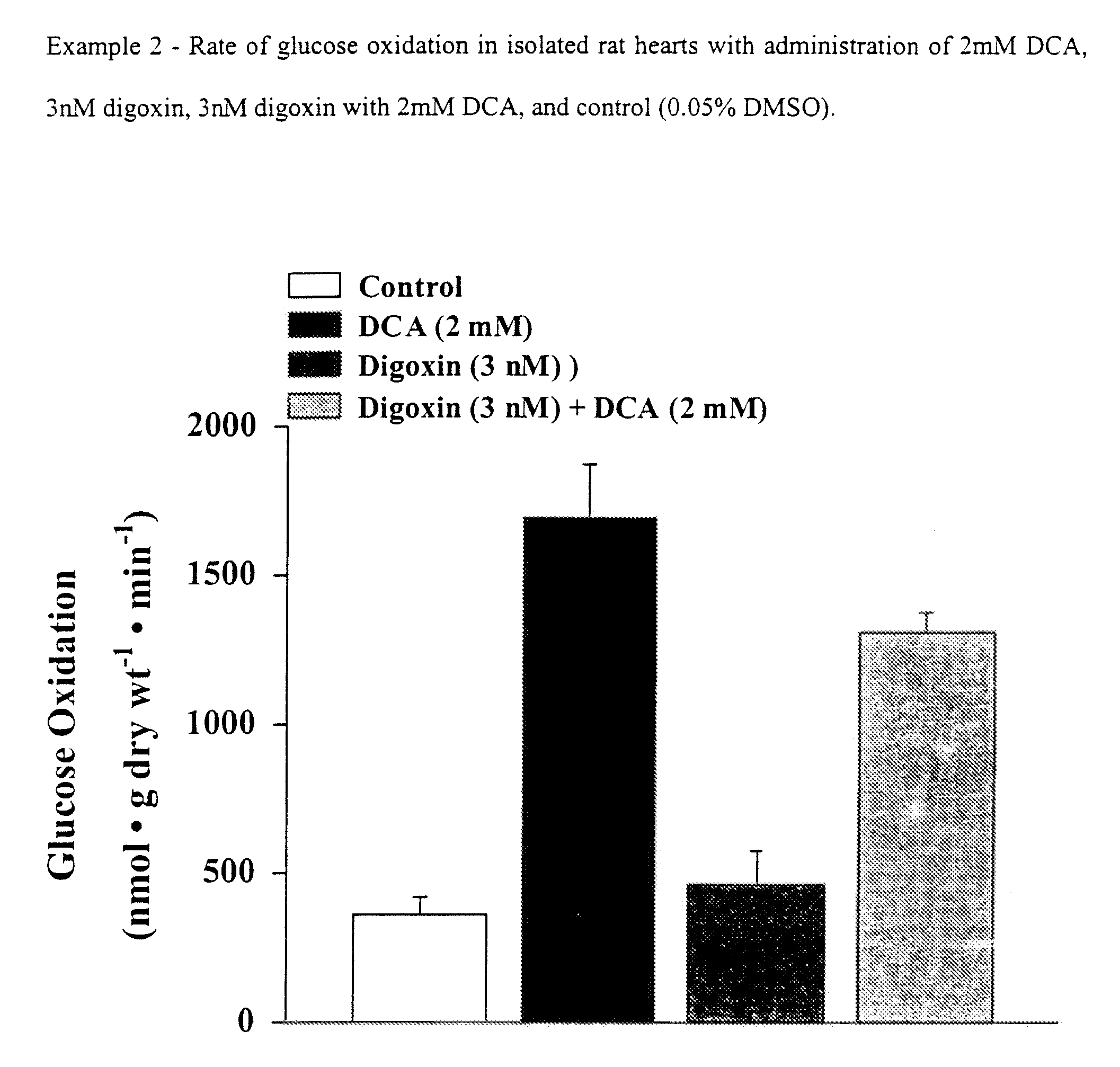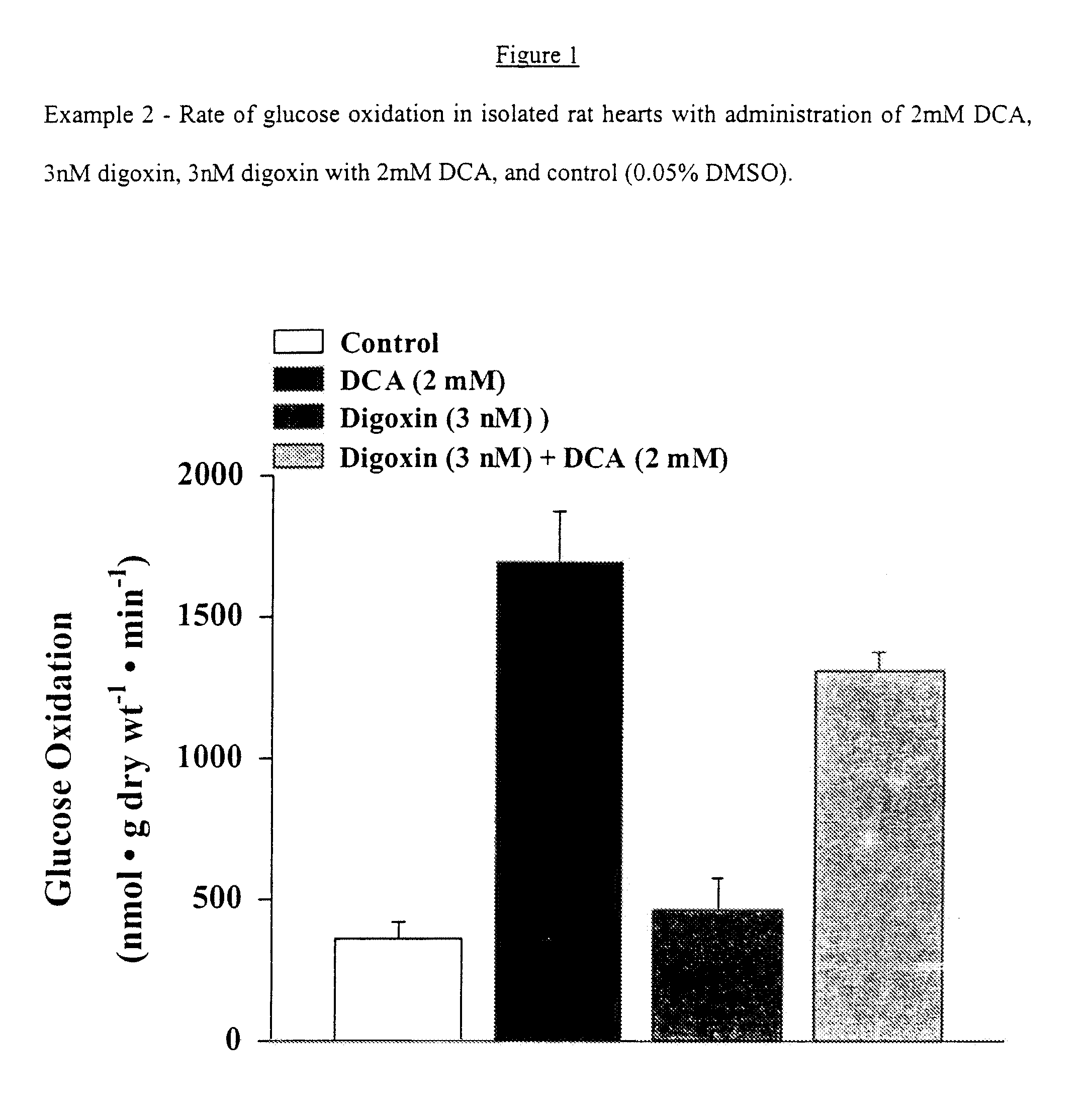Dichloracetate in combination with clinically high levels of cardioprotective or hemodynamic drugs
a technology of dichloracetate, which is applied in the field of treating cardiac dysfunction with cardioprotective or hemodynamic drugs, can solve the problems of increasing cardiac oxygen consumption, not enhancing overall mechanical efficiency, and increasing ischemic injury, so as to improve the negative side effects of a serum
- Summary
- Abstract
- Description
- Claims
- Application Information
AI Technical Summary
Benefits of technology
Problems solved by technology
Method used
Image
Examples
example 1
Effects of DCA (2 mM) on Cardiac Function and Efficiency in Normal Hearts.
[0131]As can be seen in Table 1 treatment with DCA had no significant effect on heart rate, peak systolic pressure or heart rate×peak systolic pressure (HR×PSP). In Table 2, treatment with DCA shows that there was no effect on any functional parameters, nor were there any differences in O2 consumption or cardiac efficiency.
TABLE 1Effect of various drugs on heart rate, peak systolic pressure and heart functionPeak SystolicHR × PSPHeart RatePressure(beats · min−1 ·Condition(beats · min−1)(mmHg)mmHg · 10−2)AEROBICALLYControl (0.05% DMSO) 239 ± 12137 ± 532 ± 1PERFUSEDDCA (2 mM)239 ± 8125 ± 332 ± 1Diltiazem (0.8 μM)202 ± 3127 ± 425 ± 1+DCA (2 mM) 230 ± 19131 ± 929 ± 3Digoxin (3 nM) 258 ± 11129 ± 432 ± 1+DCA (2 mM)254 ± 7121 ± 130 ± 1Metoprolol (1 μM) 250 ± 26130 ± 232 ± 4+DCA (2 mM)240 ± 6129 ± 530 ± 1Dobutamine (1 μM)333 ± 7124 ± 340 ± 2+DCA (2 mM) 312 ± 14130 ± 641 ± 4GLOBALAerobic Control 247 ± 14123 ± 4 30±ISCH...
example 2
[0132]Effects of Digoxin (3 nM) and Digoxin (3 nM) with DCA (2 mM) on Glucose Oxidation, Glycolysis, Cardiac Function and Efficiency in Normal Hearts.
[0133]As shown in FIG. 1, the Na+ / K+ ATPase inhibitor digoxin, when compared to control, did not show a significant increase in glucose oxidation rates (361±43 vs 469±111 respectively). In addition, when compared to DCA treated hearts, digoxin appears to attenuate the stimulatory effects of DCA on glucose oxidation (1697±179 vs 1314±62, respectively: FIG. 1).
[0134]In FIG. 2 DCA showed an increase in glycolysis when compared to control, but this increase was not significant (8.917±3.060 vs. 3.430±0.604, respectively). Digoxin alone increased glycolytic rates when compared to control (5.651±1.298 vs. 3.430±0.604, respectively; FIG. 2). Digoxin with DCA increased glycolytic rates when compared to control rates (9.028, vs. 3.430±0.604, respectively; FIG. 2) and DCA alone (9.028 vs. 8.917±3.060; FIG. 2).
[0135]Digoxin had no significant effe...
example 3
[0138]Effects of Diltiazem (0.8 μM) and Diltiazem (0.8 μM) with DCA (2 mM) on Glucose Oxidation, Glycolysis, Cardiac Function and Efficiency in Normal Hearts.
[0139]Diltiazem is a Ca2+ channel blocker. FIG. 3 shows that when compared to control hearts, diltiazem caused a significant decrease in the rates of glucose oxidation (361±43 vs 175:1±24 respectively). When hearts were treated with diltiazem and DCA together, the effect of diltiazem alone on glucose oxidation was blocked and a significant increase in glucose oxidation was seen when compared to control (1737±237 vs. 361±63; FIG. 3). Though, this increase in glucose oxidation was no different than treating the hearts with DCA alone (1737±264 vs. 1526±79; FIG. 3).
[0140]Diltiazem alone also had an effect on glycolytic rates when compared to control (0.727±0.160 vs. 3.430±0.604, respectively; FIG. 4). Diltiazem and DCA together result in an attenuation of the effect of DCA alone (6.865±0.887 vs. 8.917±3.060, respectively; FIG. 4). ...
PUM
 Login to View More
Login to View More Abstract
Description
Claims
Application Information
 Login to View More
Login to View More - R&D
- Intellectual Property
- Life Sciences
- Materials
- Tech Scout
- Unparalleled Data Quality
- Higher Quality Content
- 60% Fewer Hallucinations
Browse by: Latest US Patents, China's latest patents, Technical Efficacy Thesaurus, Application Domain, Technology Topic, Popular Technical Reports.
© 2025 PatSnap. All rights reserved.Legal|Privacy policy|Modern Slavery Act Transparency Statement|Sitemap|About US| Contact US: help@patsnap.com



